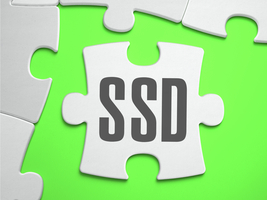We’ve all heard about solid state drives. They’re the HDD replacement that has had repeated performance gains, price drops, and reliability increases. So what do they mean for you, your computers, or your business?
Simply put, they are the difference between the past and the future.
Bottlenecks Over The Years
When computers were really taking off, we had improvements in all fields of the system. Processors and RAM were continuously upgraded and speed increases were substantial. Hard drives, unfortunately, only had gains in spurts as we moved from IDE to SATA, as well as the different generations of drives and interfaces. This is, of course, leaving out the cassette tapes and other odd storage options. Essentially, we were never slowed by the drive enough and everything else was improving in the meantime. It was a great setup. Processors had increased IPC (instructions per clock), as well as faster clock rates. More cores started appearing over time as well.
Eventually, it became necessary to find a reliable, fast, and efficient replacement for storage and programs. Eventually, it became necessary to find solid state drives.
So What Happened?
It wasn’t all that long ago that the first solid state drives appeared for consumers. The initial drives were shy of 100GB in size and had higher failure rates. Over time, however, with the backing of speed gains nearly 4x faster than standard hard disk drives, SSDs pushed the limit. Though more expensive per gigabyte, these new drives cut the load time of programs and operating systems in half. They also started to gain added warranties in the range of five to ten years as reliability was tackled. There were only two pain points left. The first was getting the idea out to people and showing the gains. The second would be more gradual. Pricing of these drives needed to become efficient for home users, enthusiasts, and businesses alike.
What Can I Gain From Upgrading?
Solid state drives increase everything about the system they are installed in. Your system acts faster than the day you bought it. The operating system load time is seconds compared to minutes. There is no downside to the new technology that is still improving upon itself. In the case of numbers, solid states blow away the older drives. Mid-range SSDs come to about 500 Megabits per second in read speeds. Alternatively, older SATA HDDs will be closer to 150 Mbps. This performance gain alone cuts down time for users in all aspects. It is also important to keep in mind the fact that your standard hard drive will have a spinning disk inside going at a rate of 7200RPM. If this disk becomes damaged or scratched your data is on the line. Instead, a solid state will hold your data safe and has a much lower rate of failure. If this wasn’t enough, it’s important to keep in mind that it takes energy to run either drive. Battery life in laptops will also see an increase when implementing a solid state drive. It’s time to restate a simple fact: there are no down sides to upgrading to the new solid state drives.
What About Price?
Pricing of SSDs has dropped dramatically. 120GB drives can be found for under $50 consistently when it was previously a price only found in the best sales. While the price per gigabyte is still higher than that of a normal HDD, there is an important note to take. In business settings, it is not terribly common to store locally. Generally, employees save and edit from a server and that is where you find terabytes of storage. As such, you can fit a cheap small SSD drive in a computer for Windows and your basic programs with no hassle. You cut out the price of that unneeded storage and put your money towards what we all want: productivity.
There is no reason not to take a jump to the newest and fastest growing section of computer hardware. More and more systems will end up with these drives as market demand pushes for cheaper, faster, and more reliable solutions for local storage. Give us a call if you have any questions — we would be happy to help bring you to the modern era of computing!
(Image Source: iCLIPART)


